Examining Strategy Development Tools in the Australian Aged Care
VerifiedAdded on 2023/06/13
|7
|1877
|496
Essay
AI Summary
This essay discusses the main strategy development tools used in the Australian aged care sector, including PESTLE, SWOT, and Resource-Based View (RBV). It highlights the increasing importance of aged care due to Australia's aging population and the need for effective strategies to support the elderly. The essay explains how tools like PESTLE analysis help understand the macro and micro environments affecting aged care, while SWOT analysis identifies internal strengths, weaknesses, opportunities, and threats. It further elaborates on how RBV can be applied to compare resources and deployment capabilities within healthcare and aged care services. The essay emphasizes the importance of aligning tasks with strategic platforms to minimize risks and achieve business objectives in the aged care sector.
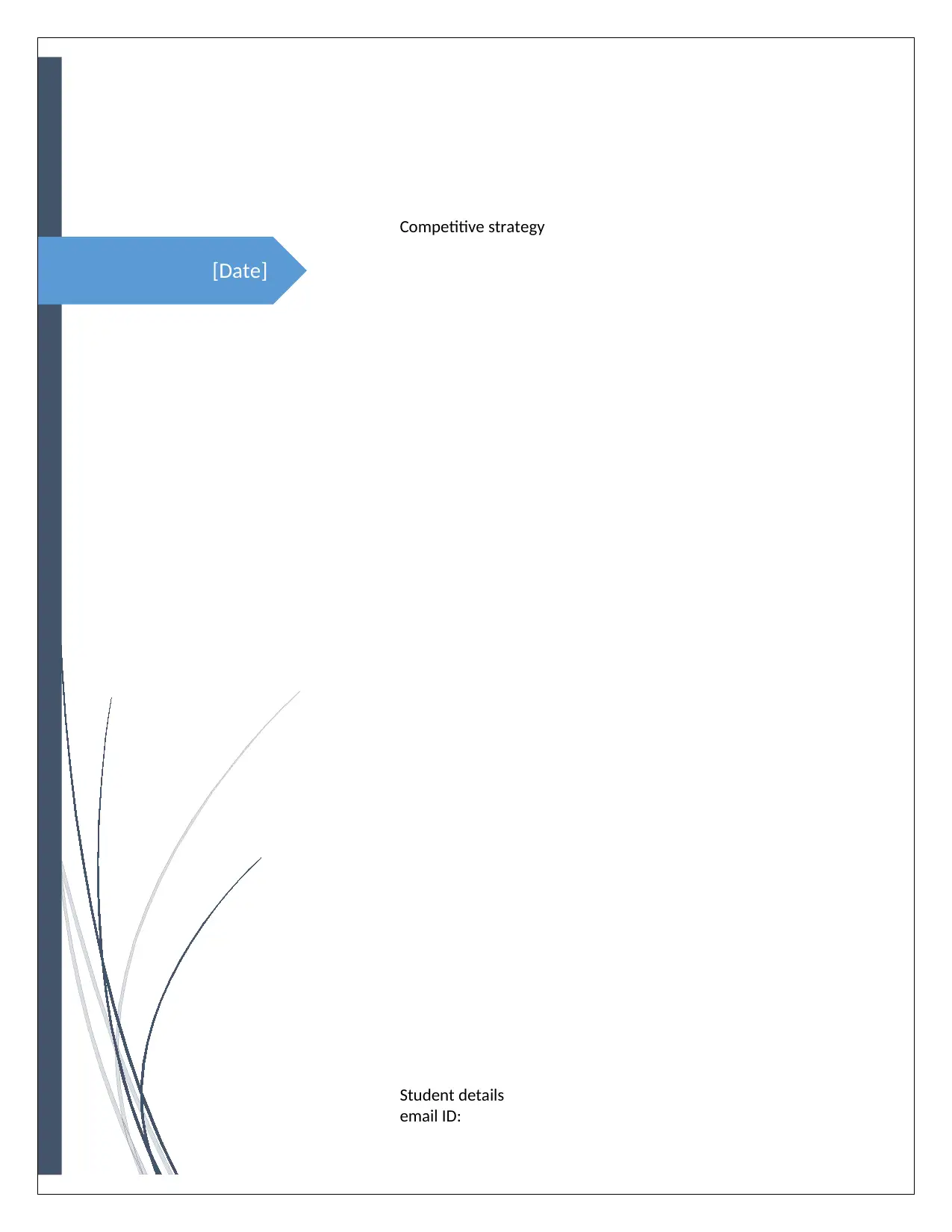
[Date]
Competitive strategy
Student details
email ID:
Competitive strategy
Student details
email ID:
Paraphrase This Document
Need a fresh take? Get an instant paraphrase of this document with our AI Paraphraser
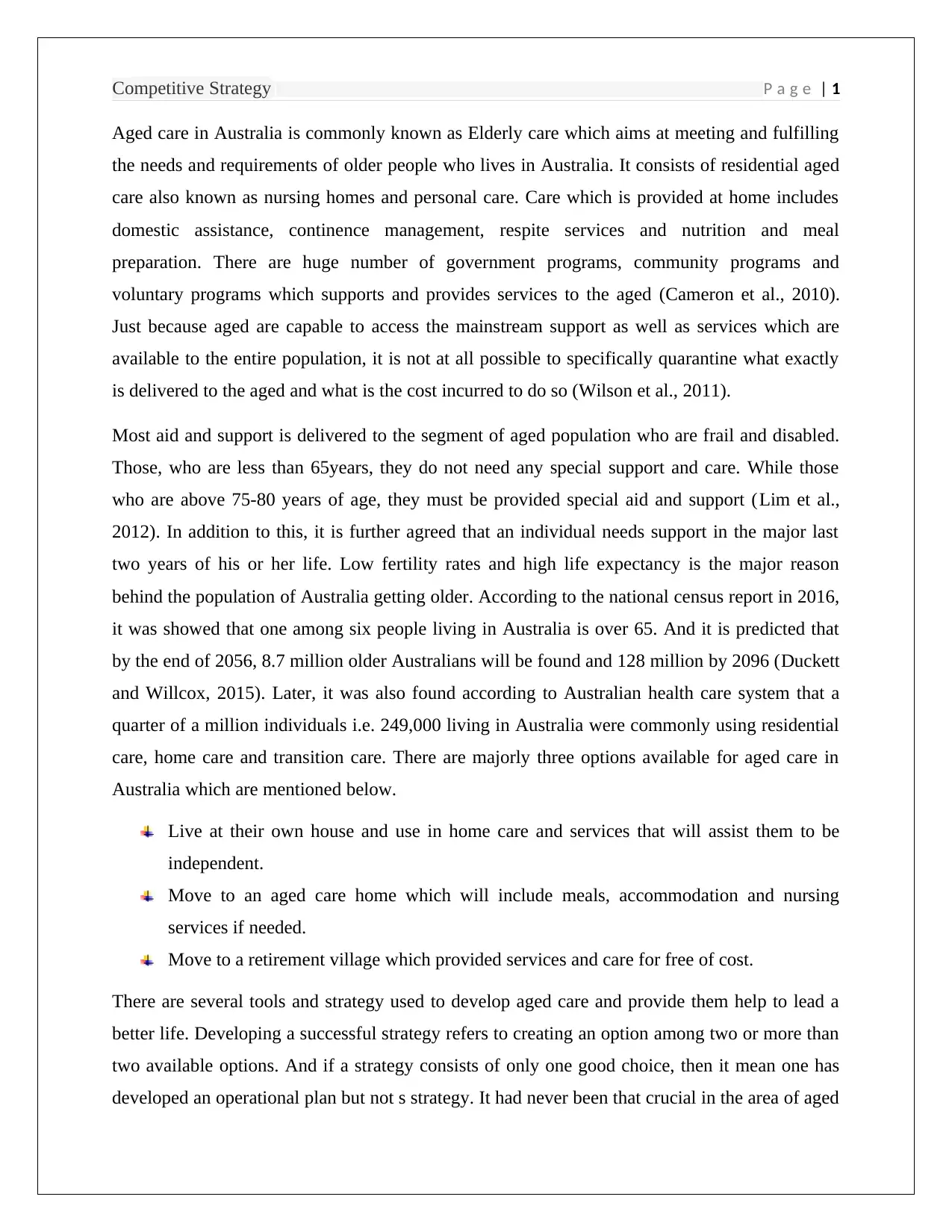
Competitive Strategy P a g e | 1
Aged care in Australia is commonly known as Elderly care which aims at meeting and fulfilling
the needs and requirements of older people who lives in Australia. It consists of residential aged
care also known as nursing homes and personal care. Care which is provided at home includes
domestic assistance, continence management, respite services and nutrition and meal
preparation. There are huge number of government programs, community programs and
voluntary programs which supports and provides services to the aged (Cameron et al., 2010).
Just because aged are capable to access the mainstream support as well as services which are
available to the entire population, it is not at all possible to specifically quarantine what exactly
is delivered to the aged and what is the cost incurred to do so (Wilson et al., 2011).
Most aid and support is delivered to the segment of aged population who are frail and disabled.
Those, who are less than 65years, they do not need any special support and care. While those
who are above 75-80 years of age, they must be provided special aid and support (Lim et al.,
2012). In addition to this, it is further agreed that an individual needs support in the major last
two years of his or her life. Low fertility rates and high life expectancy is the major reason
behind the population of Australia getting older. According to the national census report in 2016,
it was showed that one among six people living in Australia is over 65. And it is predicted that
by the end of 2056, 8.7 million older Australians will be found and 128 million by 2096 (Duckett
and Willcox, 2015). Later, it was also found according to Australian health care system that a
quarter of a million individuals i.e. 249,000 living in Australia were commonly using residential
care, home care and transition care. There are majorly three options available for aged care in
Australia which are mentioned below.
Live at their own house and use in home care and services that will assist them to be
independent.
Move to an aged care home which will include meals, accommodation and nursing
services if needed.
Move to a retirement village which provided services and care for free of cost.
There are several tools and strategy used to develop aged care and provide them help to lead a
better life. Developing a successful strategy refers to creating an option among two or more than
two available options. And if a strategy consists of only one good choice, then it mean one has
developed an operational plan but not s strategy. It had never been that crucial in the area of aged
Aged care in Australia is commonly known as Elderly care which aims at meeting and fulfilling
the needs and requirements of older people who lives in Australia. It consists of residential aged
care also known as nursing homes and personal care. Care which is provided at home includes
domestic assistance, continence management, respite services and nutrition and meal
preparation. There are huge number of government programs, community programs and
voluntary programs which supports and provides services to the aged (Cameron et al., 2010).
Just because aged are capable to access the mainstream support as well as services which are
available to the entire population, it is not at all possible to specifically quarantine what exactly
is delivered to the aged and what is the cost incurred to do so (Wilson et al., 2011).
Most aid and support is delivered to the segment of aged population who are frail and disabled.
Those, who are less than 65years, they do not need any special support and care. While those
who are above 75-80 years of age, they must be provided special aid and support (Lim et al.,
2012). In addition to this, it is further agreed that an individual needs support in the major last
two years of his or her life. Low fertility rates and high life expectancy is the major reason
behind the population of Australia getting older. According to the national census report in 2016,
it was showed that one among six people living in Australia is over 65. And it is predicted that
by the end of 2056, 8.7 million older Australians will be found and 128 million by 2096 (Duckett
and Willcox, 2015). Later, it was also found according to Australian health care system that a
quarter of a million individuals i.e. 249,000 living in Australia were commonly using residential
care, home care and transition care. There are majorly three options available for aged care in
Australia which are mentioned below.
Live at their own house and use in home care and services that will assist them to be
independent.
Move to an aged care home which will include meals, accommodation and nursing
services if needed.
Move to a retirement village which provided services and care for free of cost.
There are several tools and strategy used to develop aged care and provide them help to lead a
better life. Developing a successful strategy refers to creating an option among two or more than
two available options. And if a strategy consists of only one good choice, then it mean one has
developed an operational plan but not s strategy. It had never been that crucial in the area of aged
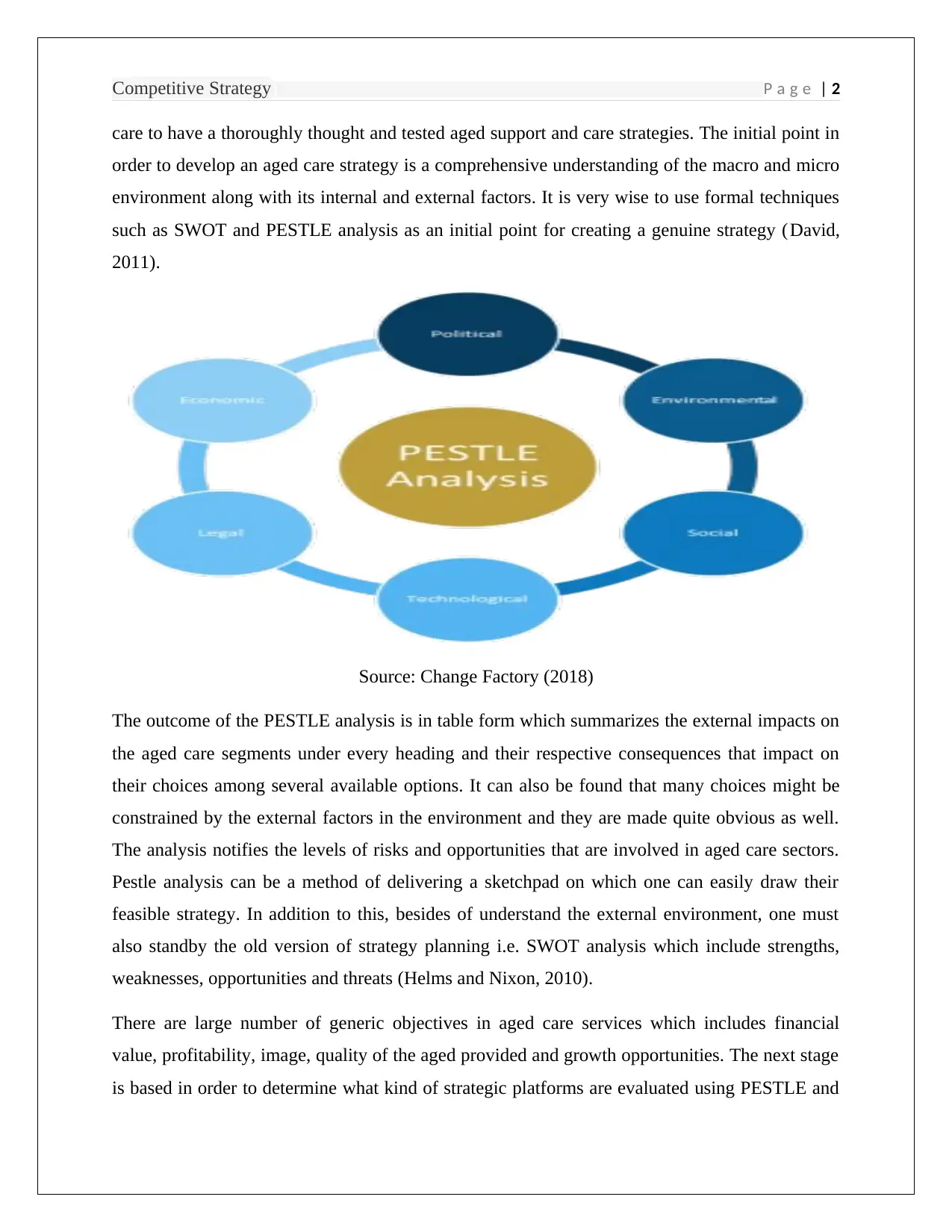
Competitive Strategy P a g e | 2
care to have a thoroughly thought and tested aged support and care strategies. The initial point in
order to develop an aged care strategy is a comprehensive understanding of the macro and micro
environment along with its internal and external factors. It is very wise to use formal techniques
such as SWOT and PESTLE analysis as an initial point for creating a genuine strategy (David,
2011).
Source: Change Factory (2018)
The outcome of the PESTLE analysis is in table form which summarizes the external impacts on
the aged care segments under every heading and their respective consequences that impact on
their choices among several available options. It can also be found that many choices might be
constrained by the external factors in the environment and they are made quite obvious as well.
The analysis notifies the levels of risks and opportunities that are involved in aged care sectors.
Pestle analysis can be a method of delivering a sketchpad on which one can easily draw their
feasible strategy. In addition to this, besides of understand the external environment, one must
also standby the old version of strategy planning i.e. SWOT analysis which include strengths,
weaknesses, opportunities and threats (Helms and Nixon, 2010).
There are large number of generic objectives in aged care services which includes financial
value, profitability, image, quality of the aged provided and growth opportunities. The next stage
is based in order to determine what kind of strategic platforms are evaluated using PESTLE and
care to have a thoroughly thought and tested aged support and care strategies. The initial point in
order to develop an aged care strategy is a comprehensive understanding of the macro and micro
environment along with its internal and external factors. It is very wise to use formal techniques
such as SWOT and PESTLE analysis as an initial point for creating a genuine strategy (David,
2011).
Source: Change Factory (2018)
The outcome of the PESTLE analysis is in table form which summarizes the external impacts on
the aged care segments under every heading and their respective consequences that impact on
their choices among several available options. It can also be found that many choices might be
constrained by the external factors in the environment and they are made quite obvious as well.
The analysis notifies the levels of risks and opportunities that are involved in aged care sectors.
Pestle analysis can be a method of delivering a sketchpad on which one can easily draw their
feasible strategy. In addition to this, besides of understand the external environment, one must
also standby the old version of strategy planning i.e. SWOT analysis which include strengths,
weaknesses, opportunities and threats (Helms and Nixon, 2010).
There are large number of generic objectives in aged care services which includes financial
value, profitability, image, quality of the aged provided and growth opportunities. The next stage
is based in order to determine what kind of strategic platforms are evaluated using PESTLE and
⊘ This is a preview!⊘
Do you want full access?
Subscribe today to unlock all pages.

Trusted by 1+ million students worldwide
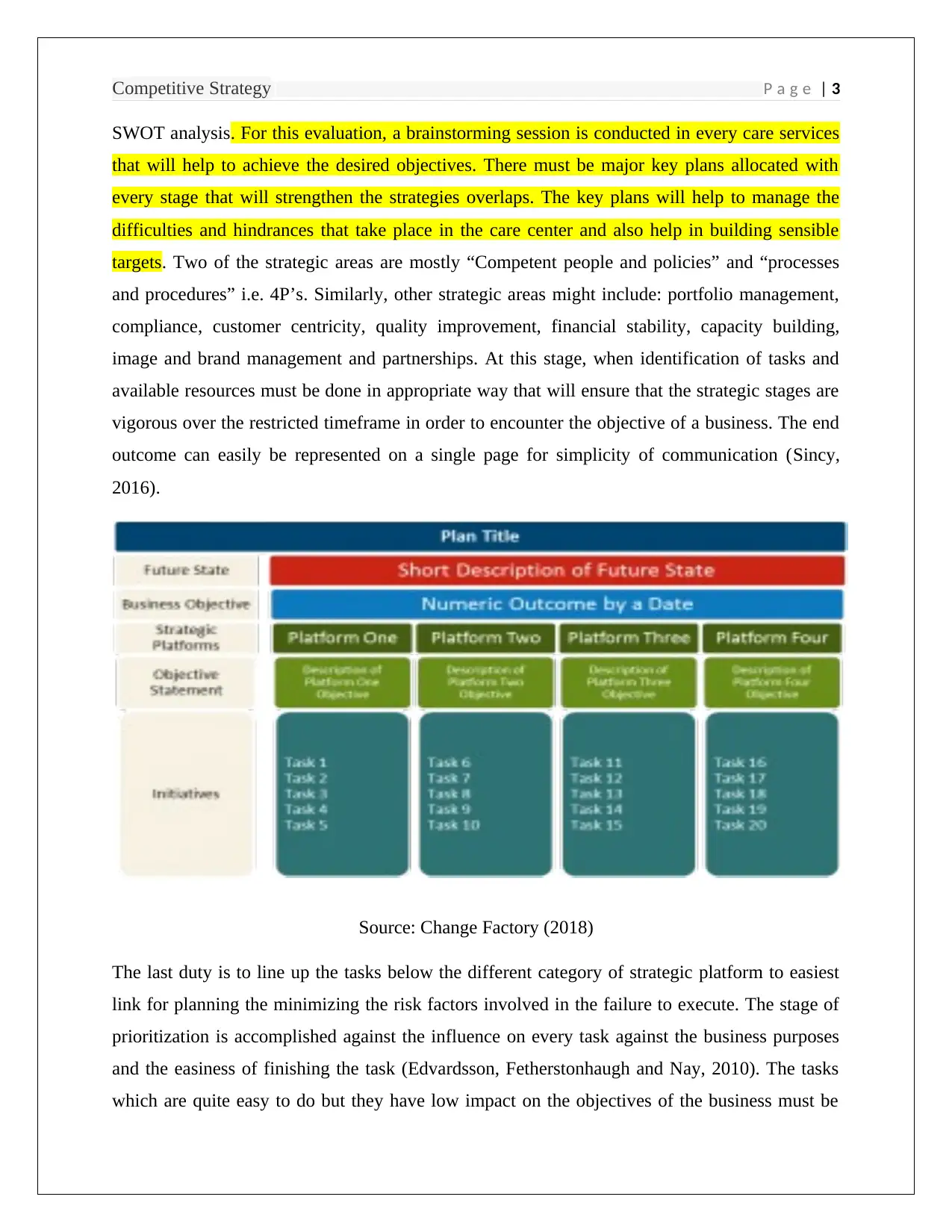
Competitive Strategy P a g e | 3
SWOT analysis. For this evaluation, a brainstorming session is conducted in every care services
that will help to achieve the desired objectives. There must be major key plans allocated with
every stage that will strengthen the strategies overlaps. The key plans will help to manage the
difficulties and hindrances that take place in the care center and also help in building sensible
targets. Two of the strategic areas are mostly “Competent people and policies” and “processes
and procedures” i.e. 4P’s. Similarly, other strategic areas might include: portfolio management,
compliance, customer centricity, quality improvement, financial stability, capacity building,
image and brand management and partnerships. At this stage, when identification of tasks and
available resources must be done in appropriate way that will ensure that the strategic stages are
vigorous over the restricted timeframe in order to encounter the objective of a business. The end
outcome can easily be represented on a single page for simplicity of communication (Sincy,
2016).
Source: Change Factory (2018)
The last duty is to line up the tasks below the different category of strategic platform to easiest
link for planning the minimizing the risk factors involved in the failure to execute. The stage of
prioritization is accomplished against the influence on every task against the business purposes
and the easiness of finishing the task (Edvardsson, Fetherstonhaugh and Nay, 2010). The tasks
which are quite easy to do but they have low impact on the objectives of the business must be
SWOT analysis. For this evaluation, a brainstorming session is conducted in every care services
that will help to achieve the desired objectives. There must be major key plans allocated with
every stage that will strengthen the strategies overlaps. The key plans will help to manage the
difficulties and hindrances that take place in the care center and also help in building sensible
targets. Two of the strategic areas are mostly “Competent people and policies” and “processes
and procedures” i.e. 4P’s. Similarly, other strategic areas might include: portfolio management,
compliance, customer centricity, quality improvement, financial stability, capacity building,
image and brand management and partnerships. At this stage, when identification of tasks and
available resources must be done in appropriate way that will ensure that the strategic stages are
vigorous over the restricted timeframe in order to encounter the objective of a business. The end
outcome can easily be represented on a single page for simplicity of communication (Sincy,
2016).
Source: Change Factory (2018)
The last duty is to line up the tasks below the different category of strategic platform to easiest
link for planning the minimizing the risk factors involved in the failure to execute. The stage of
prioritization is accomplished against the influence on every task against the business purposes
and the easiness of finishing the task (Edvardsson, Fetherstonhaugh and Nay, 2010). The tasks
which are quite easy to do but they have low impact on the objectives of the business must be
Paraphrase This Document
Need a fresh take? Get an instant paraphrase of this document with our AI Paraphraser
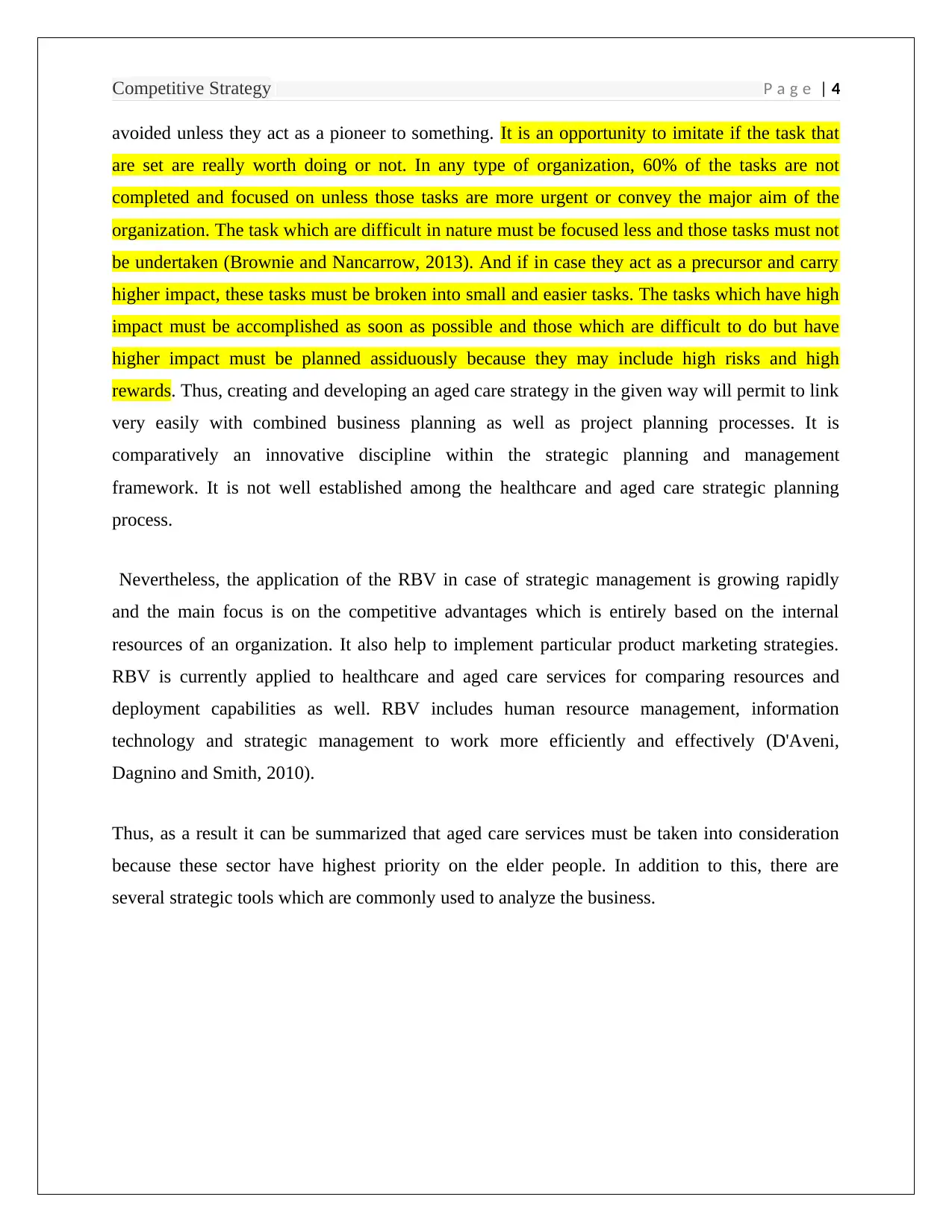
Competitive Strategy P a g e | 4
avoided unless they act as a pioneer to something. It is an opportunity to imitate if the task that
are set are really worth doing or not. In any type of organization, 60% of the tasks are not
completed and focused on unless those tasks are more urgent or convey the major aim of the
organization. The task which are difficult in nature must be focused less and those tasks must not
be undertaken (Brownie and Nancarrow, 2013). And if in case they act as a precursor and carry
higher impact, these tasks must be broken into small and easier tasks. The tasks which have high
impact must be accomplished as soon as possible and those which are difficult to do but have
higher impact must be planned assiduously because they may include high risks and high
rewards. Thus, creating and developing an aged care strategy in the given way will permit to link
very easily with combined business planning as well as project planning processes. It is
comparatively an innovative discipline within the strategic planning and management
framework. It is not well established among the healthcare and aged care strategic planning
process.
Nevertheless, the application of the RBV in case of strategic management is growing rapidly
and the main focus is on the competitive advantages which is entirely based on the internal
resources of an organization. It also help to implement particular product marketing strategies.
RBV is currently applied to healthcare and aged care services for comparing resources and
deployment capabilities as well. RBV includes human resource management, information
technology and strategic management to work more efficiently and effectively (D'Aveni,
Dagnino and Smith, 2010).
Thus, as a result it can be summarized that aged care services must be taken into consideration
because these sector have highest priority on the elder people. In addition to this, there are
several strategic tools which are commonly used to analyze the business.
avoided unless they act as a pioneer to something. It is an opportunity to imitate if the task that
are set are really worth doing or not. In any type of organization, 60% of the tasks are not
completed and focused on unless those tasks are more urgent or convey the major aim of the
organization. The task which are difficult in nature must be focused less and those tasks must not
be undertaken (Brownie and Nancarrow, 2013). And if in case they act as a precursor and carry
higher impact, these tasks must be broken into small and easier tasks. The tasks which have high
impact must be accomplished as soon as possible and those which are difficult to do but have
higher impact must be planned assiduously because they may include high risks and high
rewards. Thus, creating and developing an aged care strategy in the given way will permit to link
very easily with combined business planning as well as project planning processes. It is
comparatively an innovative discipline within the strategic planning and management
framework. It is not well established among the healthcare and aged care strategic planning
process.
Nevertheless, the application of the RBV in case of strategic management is growing rapidly
and the main focus is on the competitive advantages which is entirely based on the internal
resources of an organization. It also help to implement particular product marketing strategies.
RBV is currently applied to healthcare and aged care services for comparing resources and
deployment capabilities as well. RBV includes human resource management, information
technology and strategic management to work more efficiently and effectively (D'Aveni,
Dagnino and Smith, 2010).
Thus, as a result it can be summarized that aged care services must be taken into consideration
because these sector have highest priority on the elder people. In addition to this, there are
several strategic tools which are commonly used to analyze the business.
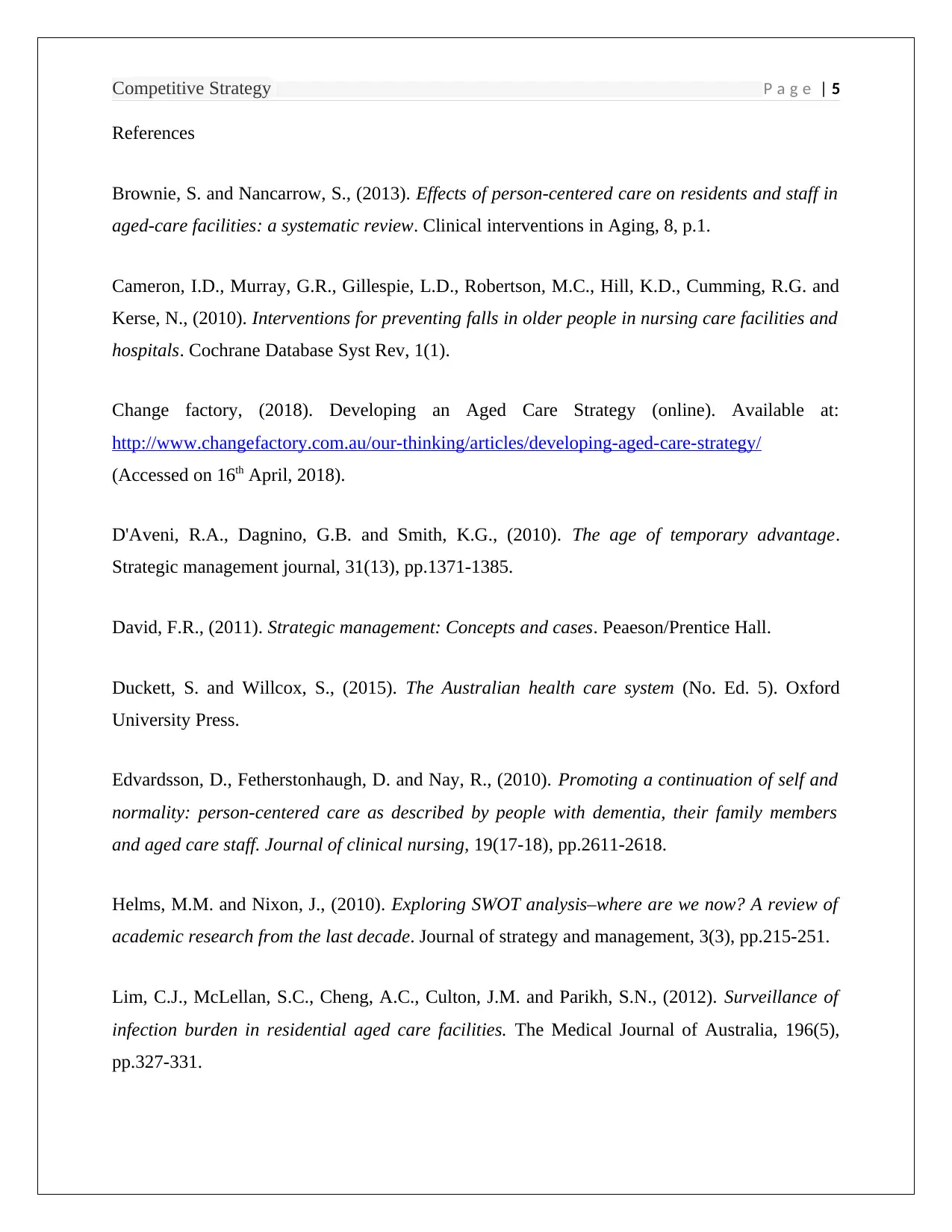
Competitive Strategy P a g e | 5
References
Brownie, S. and Nancarrow, S., (2013). Effects of person-centered care on residents and staff in
aged-care facilities: a systematic review. Clinical interventions in Aging, 8, p.1.
Cameron, I.D., Murray, G.R., Gillespie, L.D., Robertson, M.C., Hill, K.D., Cumming, R.G. and
Kerse, N., (2010). Interventions for preventing falls in older people in nursing care facilities and
hospitals. Cochrane Database Syst Rev, 1(1).
Change factory, (2018). Developing an Aged Care Strategy (online). Available at:
http://www.changefactory.com.au/our-thinking/articles/developing-aged-care-strategy/
(Accessed on 16th April, 2018).
D'Aveni, R.A., Dagnino, G.B. and Smith, K.G., (2010). The age of temporary advantage.
Strategic management journal, 31(13), pp.1371-1385.
David, F.R., (2011). Strategic management: Concepts and cases. Peaeson/Prentice Hall.
Duckett, S. and Willcox, S., (2015). The Australian health care system (No. Ed. 5). Oxford
University Press.
Edvardsson, D., Fetherstonhaugh, D. and Nay, R., (2010). Promoting a continuation of self and
normality: person‐centered care as described by people with dementia, their family members
and aged care staff. Journal of clinical nursing, 19(17‐18), pp.2611-2618.
Helms, M.M. and Nixon, J., (2010). Exploring SWOT analysis–where are we now? A review of
academic research from the last decade. Journal of strategy and management, 3(3), pp.215-251.
Lim, C.J., McLellan, S.C., Cheng, A.C., Culton, J.M. and Parikh, S.N., (2012). Surveillance of
infection burden in residential aged care facilities. The Medical Journal of Australia, 196(5),
pp.327-331.
References
Brownie, S. and Nancarrow, S., (2013). Effects of person-centered care on residents and staff in
aged-care facilities: a systematic review. Clinical interventions in Aging, 8, p.1.
Cameron, I.D., Murray, G.R., Gillespie, L.D., Robertson, M.C., Hill, K.D., Cumming, R.G. and
Kerse, N., (2010). Interventions for preventing falls in older people in nursing care facilities and
hospitals. Cochrane Database Syst Rev, 1(1).
Change factory, (2018). Developing an Aged Care Strategy (online). Available at:
http://www.changefactory.com.au/our-thinking/articles/developing-aged-care-strategy/
(Accessed on 16th April, 2018).
D'Aveni, R.A., Dagnino, G.B. and Smith, K.G., (2010). The age of temporary advantage.
Strategic management journal, 31(13), pp.1371-1385.
David, F.R., (2011). Strategic management: Concepts and cases. Peaeson/Prentice Hall.
Duckett, S. and Willcox, S., (2015). The Australian health care system (No. Ed. 5). Oxford
University Press.
Edvardsson, D., Fetherstonhaugh, D. and Nay, R., (2010). Promoting a continuation of self and
normality: person‐centered care as described by people with dementia, their family members
and aged care staff. Journal of clinical nursing, 19(17‐18), pp.2611-2618.
Helms, M.M. and Nixon, J., (2010). Exploring SWOT analysis–where are we now? A review of
academic research from the last decade. Journal of strategy and management, 3(3), pp.215-251.
Lim, C.J., McLellan, S.C., Cheng, A.C., Culton, J.M. and Parikh, S.N., (2012). Surveillance of
infection burden in residential aged care facilities. The Medical Journal of Australia, 196(5),
pp.327-331.
⊘ This is a preview!⊘
Do you want full access?
Subscribe today to unlock all pages.

Trusted by 1+ million students worldwide
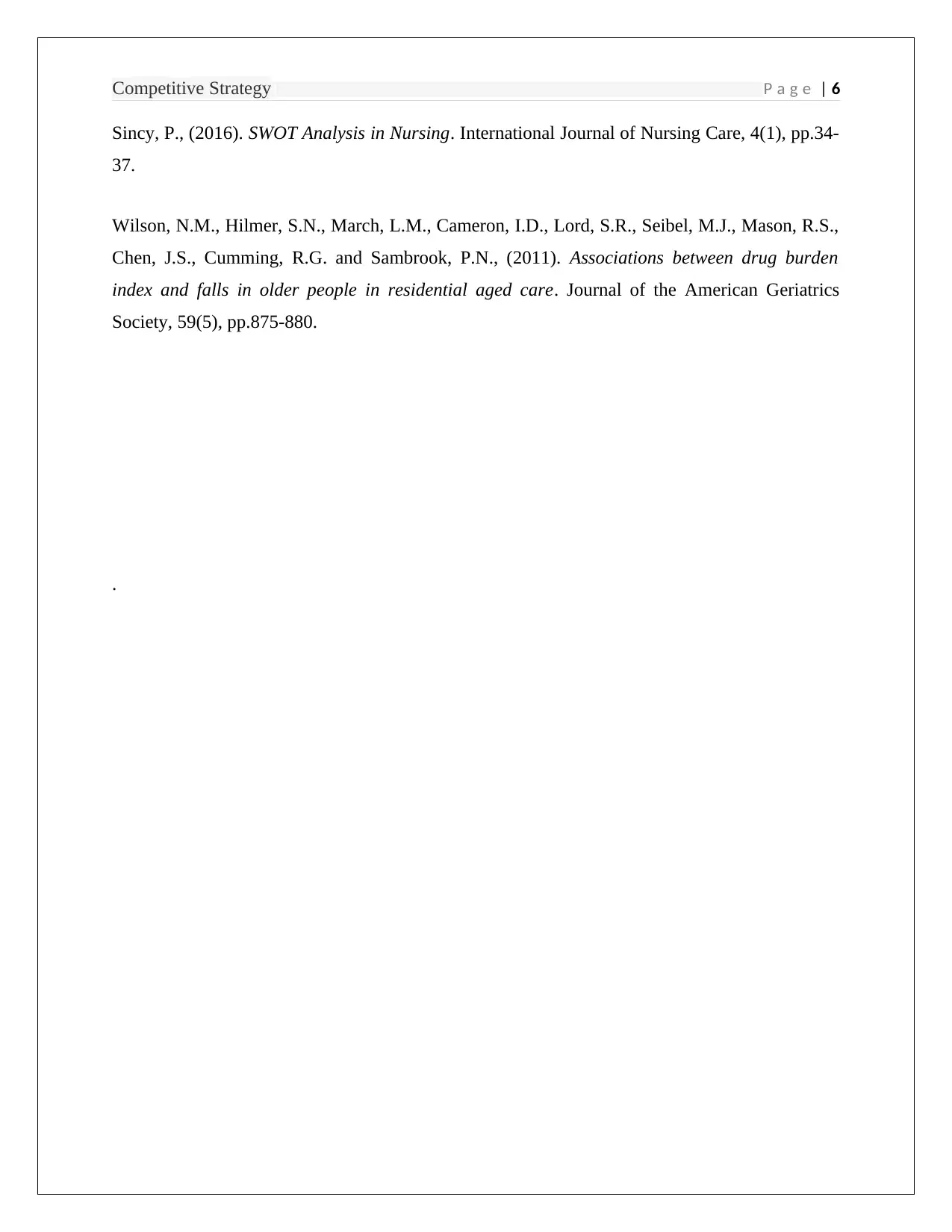
Competitive Strategy P a g e | 6
Sincy, P., (2016). SWOT Analysis in Nursing. International Journal of Nursing Care, 4(1), pp.34-
37.
Wilson, N.M., Hilmer, S.N., March, L.M., Cameron, I.D., Lord, S.R., Seibel, M.J., Mason, R.S.,
Chen, J.S., Cumming, R.G. and Sambrook, P.N., (2011). Associations between drug burden
index and falls in older people in residential aged care. Journal of the American Geriatrics
Society, 59(5), pp.875-880.
.
Sincy, P., (2016). SWOT Analysis in Nursing. International Journal of Nursing Care, 4(1), pp.34-
37.
Wilson, N.M., Hilmer, S.N., March, L.M., Cameron, I.D., Lord, S.R., Seibel, M.J., Mason, R.S.,
Chen, J.S., Cumming, R.G. and Sambrook, P.N., (2011). Associations between drug burden
index and falls in older people in residential aged care. Journal of the American Geriatrics
Society, 59(5), pp.875-880.
.
1 out of 7
Related Documents
Your All-in-One AI-Powered Toolkit for Academic Success.
+13062052269
info@desklib.com
Available 24*7 on WhatsApp / Email
![[object Object]](/_next/static/media/star-bottom.7253800d.svg)
Unlock your academic potential
Copyright © 2020–2025 A2Z Services. All Rights Reserved. Developed and managed by ZUCOL.



